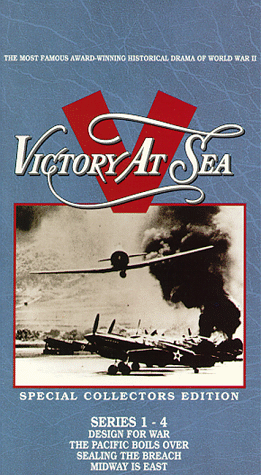
 |
And Now . . .
| TV Date | Episode | Subject |
| October 26, 1952 | DESIGN FOR WAR | Battle of the Atlantic, 1939-1941 |
| November 2, 1952 | THE PACIFIC BOILS OVER | Pearl Harbor, December 7, 1941 |
| November 9, 1952 | SEALING THE BREACH | Anti-submarine warfare, 1941-1943 |
| November 23, 1952 | MIDWAY IS EAST | Japanese victories & the Midway Battle |
| November 30, 1952 | MEDITERRANEAN MOSAIC | Gibraltar, Allied & enemy fleets, Malta |
| December 14, 1952 | GUADALCANAL | Guadalcanal |
| December 21, 1952 | RINGS AROUND RABAUL | Struggle for the Solomon Islands |
| December 28, 1952 | MARE NOSTRUM | Mediterranean Command, 1940-1942 |
| January 4, 1953 | SEA AND SAND | Invasion of North Africa, 1942-1943 |
| January 11, 1953 | BENEATH THE SOUTHERN CROSS | War in the south Atlantic |
| January 18, 1953 | MAGNETIC NORTH | War from Murmansk to Alaska |
| January 25, 1953 | THE CONQUEST OF MICRONESIA | Carrier warfare--Gilberts and Marshalls |
| February 1, 1953 | MELANESIAN NIGHTMARE | New Guinea campaign |
| February 8, 1953 | ROMAN RENAISSANCE | Sicily and the Italian campaign |
| February 15, 1953 | D-DAY | Normandy |
| February 22, 1953 | KILLERS AND THE KILLED | Victory in the Atlantic, 1943-1945 |
| March 1, 1953 | THE TURKEY SHOOT | Conquest of the Marianas |
| March 8, 1953 | TWO IF BY SEA | Peleliu and Angaur |
| March 15, 1953 | BATTLE FOR LEYTE GULF | Sea battle for Leyte Gulf |
| March 22, 1953 | RETURN OF THE ALLIES | Liberation of the Philippines |
| March 29, 1953 | FULL FATHOM FIVE | U.S. submarines, 1941-194 |
| April 5, 1953 | THE FATE OF EUROPE | Black Sea, south of France, surrender |
| April 12,1953 | TARGET SURIBACHI | Iwo Jima |
| April 19, 1953 | THE ROAD TO MANDALAY | China, Burma, India, and Indian Ocean |
| April 26, 1953 | SUICIDE FOR GLORY | Okinawa |
| May 3, 1953 | DESIGN FOR PEACE | Surrender of Japan & aftermath of war |